I always enjoy mysteries in my photos like this one, especially when they involve bird behaviors. And sometimes my readers even solve them for me.
Five days ago I spent quite a while photographing Snowy Egrets hunting in duckweed and algae-covered water at Bear River MBR. The following nine photos were taken in a burst of 10 shots as one of the egrets rushed potential prey, stabbed at it with its bill and then reacted to the result. The photos are presented sequentially and the total elapsed time (including the missing photo) was exactly one second.
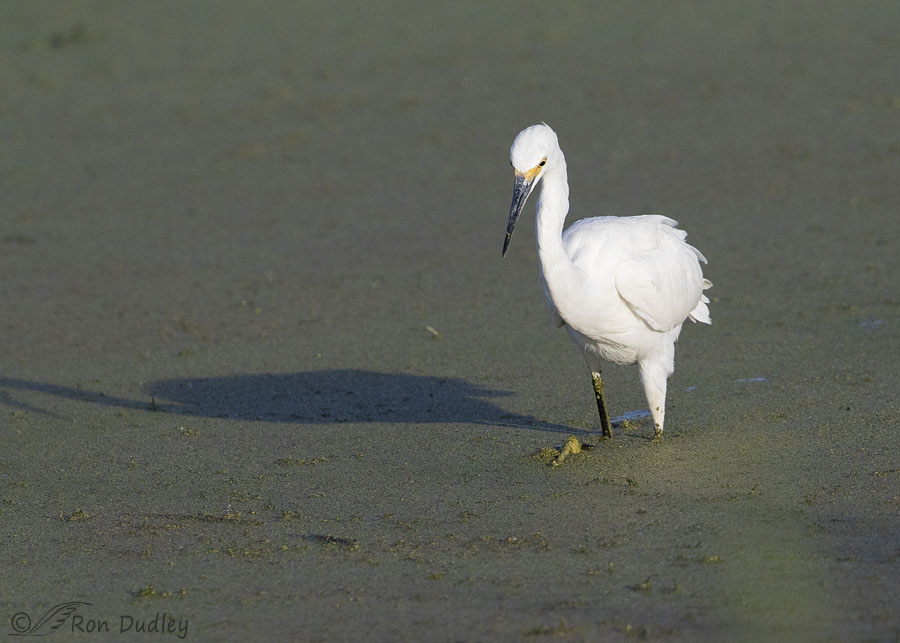
1/5000, f/6.3, ISO 800, Canon 7D Mark II, Canon EF 500mm f/4L IS II USM + EF 1.4 III Extender, not baited, set up or called in
I don’t know for sure how the egrets could somehow sense prey (usually small fish) beneath the thick matt of duckweed and algae but they were pretty darned good at it. This bird has somehow detected potential prey beneath the duckweed directly in front of “him” and is beginning to move toward it.
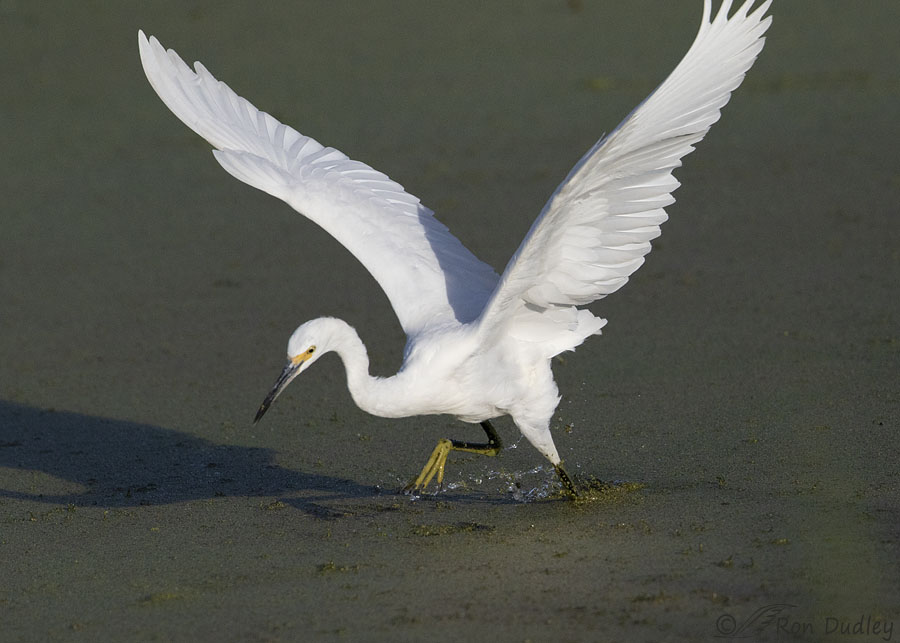
1/8000, f/6.3, ISO 800, Canon 7D Mark II, Canon EF 500mm f/4L IS II USM + EF 1.4 III Extender, not baited, set up or called in
Egrets are incredibly fast in these situations so I was lucky to only clip one wing.
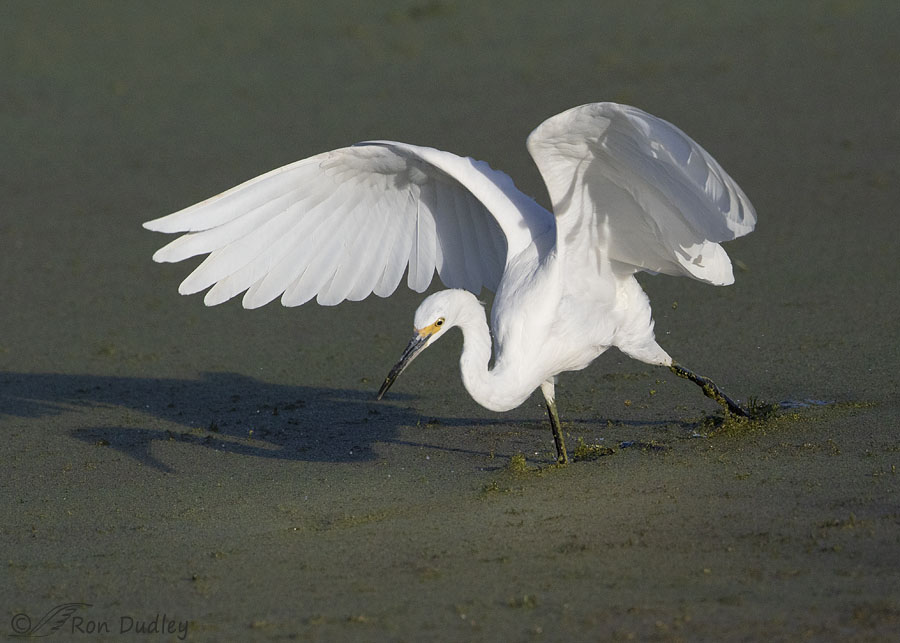
1/8000, f/6.3, ISO 800, Canon 7D Mark II, Canon EF 500mm f/4L IS II USM + EF 1.4 III Extender, not baited, set up or called in
Here he’s about to strike but I still don’t see what captured his interest. It was probably just a very small disturbance in the floating duckweed.
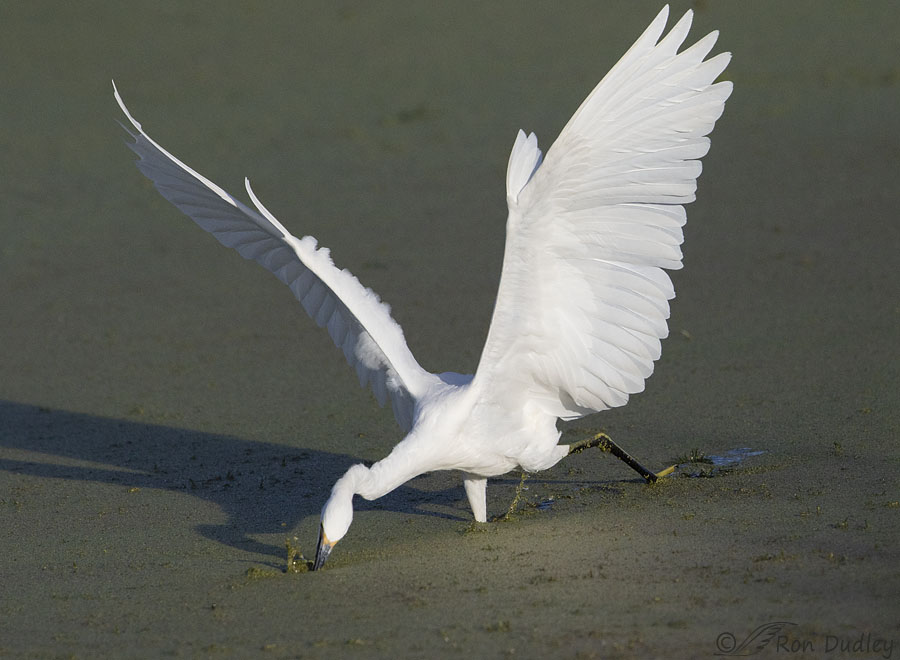
1/8000, f/6.3, ISO 800, Canon 7D Mark II, Canon EF 500mm f/4L IS II USM + EF 1.4 III Extender, not baited, set up or called in
I thought two things were interesting in this shot: he turned his head at almost a 45° angle to make the strike and he fully deployed his alulae to get as much “traction” in the air with his wings as possible to stop his forward momentum. In the previous photo the alulae weren’t flared at all.
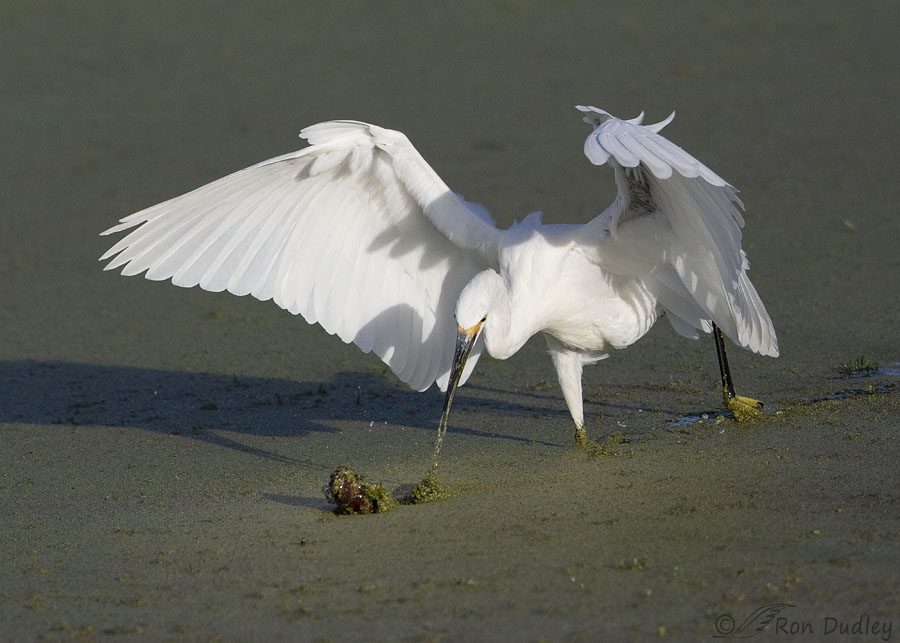
1/8000, f/6.3, ISO 800, Canon 7D Mark II, Canon EF 500mm f/4L IS II USM + EF 1.4 III Extender, not baited, set up or called in
He came up empty but something? popped up out of the water directly in front of the spot where his bill had plunged into the water.
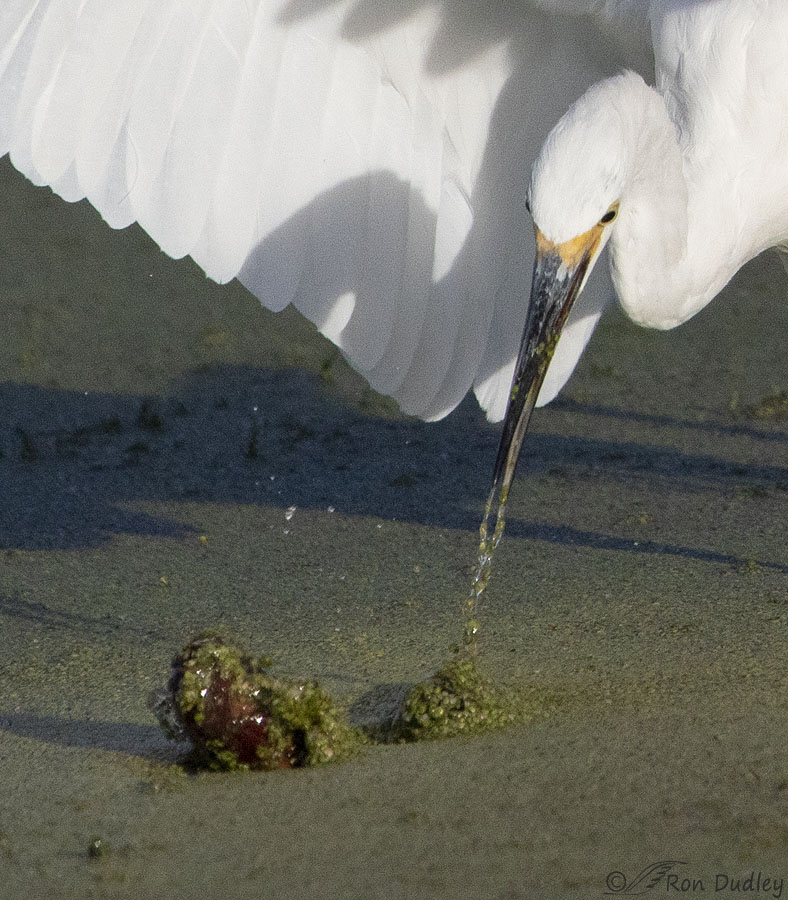
I thought I might be able to tell what it was if I cropped tightly on it but I can’t. The fact that it isn’t sharp because it’s out of my plane of critical focus doesn’t help. I can’t even tell for sure if it’s an animate or an inanimate object, although I suspect the latter.
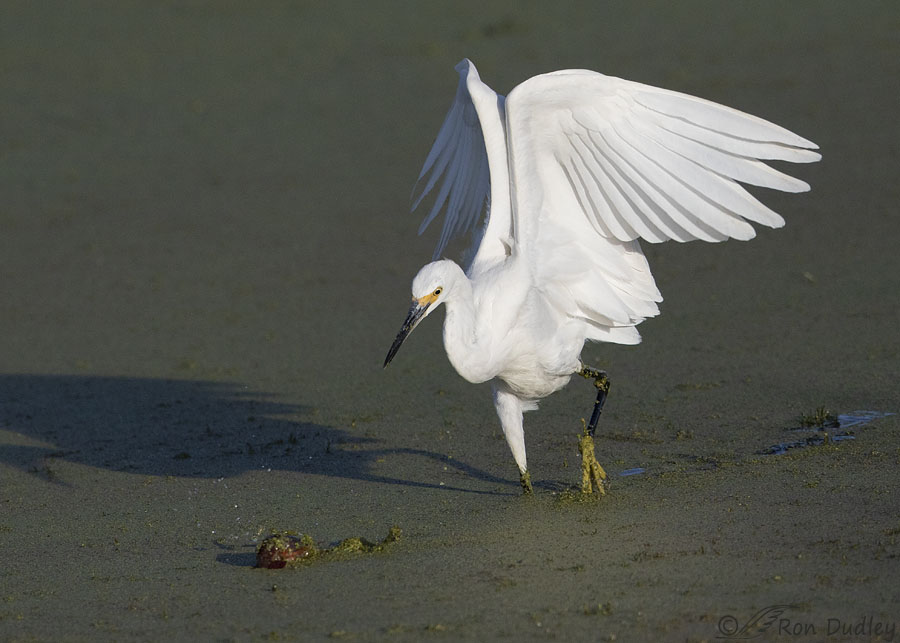
1/6400, f/6.3, ISO 800, Canon 7D Mark II, Canon EF 500mm f/4L IS II USM + EF 1.4 III Extender, not baited, set up or called in
1/10th of a second later the egret has pulled away and the “item” is falling back beneath the duckweed.
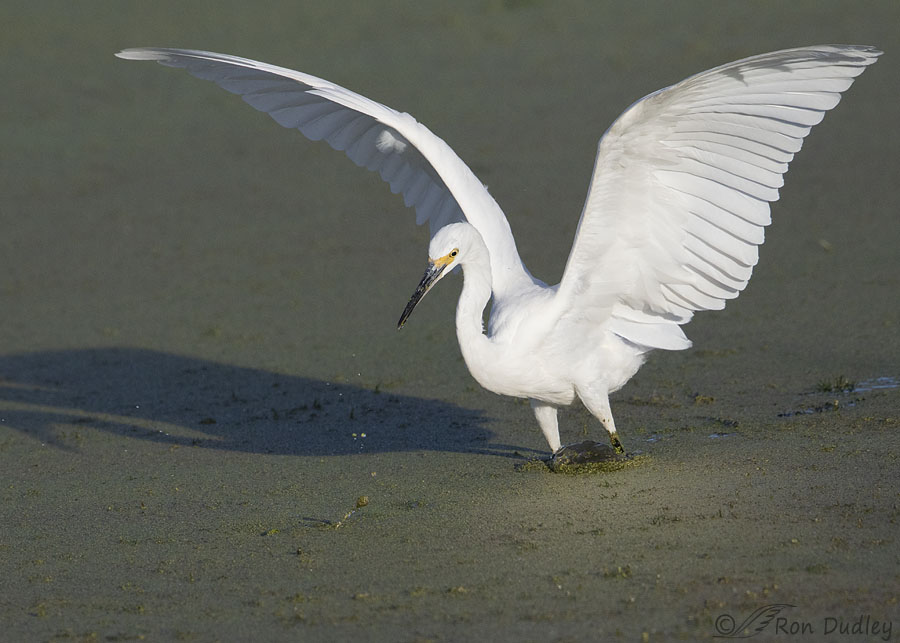
1/5000, f/6.3, ISO 800, Canon 7D Mark II, Canon EF 500mm f/4L IS II USM + EF 1.4 III Extender, not baited, set up or called in
By the next shot it has disappeared, leaving behind only a few drops of duckweed-laden water falling back to the surface.
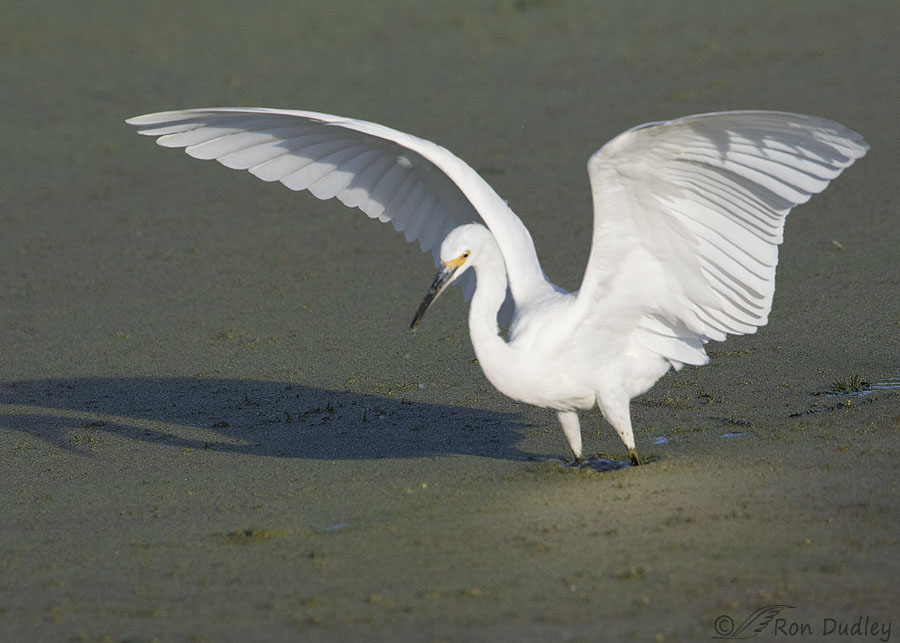
1/4000, f/6.3, ISO 800, Canon 7D Mark II, Canon EF 500mm f/4L IS II USM + EF 1.4 III Extender, not baited, set up or called in
And now it’s completely gone. The only evidence it was ever there is the tiny spot of blue water and the egret showed no further interest in it. The bird is soft but I wanted to include this shot anyway to complete the series.
I can only guess what it was and in the end it doesn’t matter much, if at all, but stuff like this makes me curious as hell. My best guess is that it’s a small piece of wood that was “upended” when the egret struck one end of it but wood on the refuge is almost nonexistent and it doesn’t float. It doesn’t appear to be a fish or any other organism I recognize.
Any thoughts? Perhaps it’s something completely obvious and I’m just oblivious to it. If so it won’t be the first time…
Ron


I am thinking that because the Egret didn’t give it a second strike, that it must be inanimate. The Egret may have missed a small fish and poked a water soaked piece of wood loose from the shallow bottom.
That’s a possibility, Gary – despite the relative scarceness of wood in the area. It could have come from the Bear River upstream and been in the water for a very long time.
Fantastic shots of the Snowy — absolutely gorgeous! And yay for alulae — “bird thumbs” for the win!
My first thought was froggy, but I have no idea, so just call me Ms. Helpful. I followed the link (thanks, Martha. Ew) and totally understand how those critters got their nicknames.
Thanks, Marty. I’m still clueless too and I’ll probably remain so but then I’ve been there before so it’s familiar territory.
I am as usual clueless about the mystery.
And equally as usual awed and delighted by the series (the third and the fifth in particular).
Many, many thanks.
Thank you, EC.
In the interest of science, and in recognition of your years as a biology educator, and to oblige all your Feathered Photography devotees, I think it is incumbent on you to don a pair of waders and retrieve the object. You might want to tie a rope to yourself and the truck so you can pull yourself out if necessary.
Ha, don’t think I’d go into that soupy mess unless I was guaranteed to find it, Lyle. And that isn’t likely…
The Fat Innkeeper, I believe, is strictly a marine species. There are freshwater annelids that are eaten by Snowy Egrets, but generally, they are not probed for in water more than an inch or so deep. They are exposed and near the surface of the mud in very shallow water and so are easier to find. In water of more depth, these worms are usually only taken if disturbed from their burrow in the mud. Egrets certainly make foot movements that could disturb these animals, but I see no evidence in the photos of such action by this bird. The water surface looks smooth before the strike. It’s hard to tell if the object in question is what the bird sought or something disturbed by its actions. I can’t tell what it might be. If you solve the mystery I’m sure we would all love to know what you found.
Snowy Egrets often use that bright yellow foot as a foot lure. Moving it back and forth attracts the attention of fish which become the heron’s meal if they come too close to investigate. This water seems too murky for the foot to be easily seen but I have seen this behavior many times in clear water.
I’ve seen the behavior you describe too, Dan – many times. And this bird didn’t appear to be doing it nor did any of the other egrets that morning.
I’ll be sure to report back if this “thing” is ever conclusively identified.
It looked like something alive to me. Not wood. Hope you get resolution on it identity! Linda
I hope so too, Linda.
Marine biologist here, at your service. I don’t know whether you have these species in your area, but there are annelid worms called clitellata that are red, coil up, might be the prey. Ditto leeches. But this creature appears to have a siphon, and a back end and a front end, and a body under the surface between the back and large front. Given its size relative to the egret’s bill, I’m going to say hypothesis #1 is it’s a worm called the Fat Innkeeper. Here is a lot of info on this species, some of which is ewwww. https://en.wikipedia.org/wiki/Urechis_unicinctus
Hmmm, I see it’s also called the penis fish. So many ways to go with that…
However, no matter what you call it that worm is apparently strictly marine and the refuge is fresh water.
Marvelous series Ron!
Charlotte
Thanks, Charlotte.
Fascinating series– I liked your observation about the deployed allula used as sort of brake. The object seemed very RED and shiny to me–too much so to be old wood……it almost looked
like a discarded organ from a large mammal…..maybe a raptor’s find from a discarded hunter’s “gut pile” that was accidentally dropped in flight ? That’s MY flight of ( disgusting ) imagination
for today !
Kris, there’s no mammal hunting allowed on the refuge, only waterfowl and that season hadn’t started yet.
I do tend to pay attention to the allulae. Science still hasn’t figured out how they work (for example, whether they’re deployed automatically or it’s under muscular control).
Great series. I think it is something alive and not a piece of wood. I don’t think a piece of wood would have popped up like that just because the Egret struck behind that spot. And then I don’t think a piece of wood could have then disappeared on its own. Whatever it is it must have moved to have attracted the Egret’s attention, and then when the Egret failed to grab it, it went back down. It seems that it was something the Egret did not want that’s for sure because he certainly could have grabbed it. The problem is that it does not look like anything that would normally pop up like that. Here I see them and the Ibis and others grabbing Crayfish/Crawfish, but that sure doesn’t look like one. Maybe a marine biologist will see the post and ID the mysterious creature. That Duckweed and algae sure make for an ugly background for that beautiful Egret.
“Whatever it is it must have moved to have attracted the Egret’s attention”
That’s exactly what I keep thinking, Everett. Of course it’s possible there was a small fish right next to it but that seems like a bit of a long shot.
Hmm…could be the creature from the green lagoon. Sure seems like a chunk ‘o wood, but perhaps we shouldn’t rush to judgement. I’m not that familiar with the physical properties of a duckweed blanket as I am mostly a land critter these days, but I notice in the shot where the mystery thing is much out of the water that there is no surface bulge around the point of exit. Also in the before strike shots, the water surface appears to be very smooth with no indication of a floating piece of wood and it came out of the water quite a ways after the strike. I realize there’s a lot of energy in an egret’s strike but there’s a lot of inertia in a water logged piece of wood. Who’s to say that the creature from the green lagoon doesn’t have great camouflaging capabilities. Great mystery and I love the continuous shot sequence.
Interesting analysis Dave. Perplexing isn’t it.
Beautiful bird and action documentation……. They sure are FAST even after “tippy toeing” around……
They sure are FAST even after “tippy toeing” around……  The object does look like a piece of wood that had been there a LONG time – hard to tell! Perhaps there had been a small fish by it that caught the Egret’s attention? Storm seems to be winding down – one “widowmaker” branch hanging in the lane that I know of. Know they had a Blizzard warning in the Cut Bank area S to Augusta area yesterday afternoon……
The object does look like a piece of wood that had been there a LONG time – hard to tell! Perhaps there had been a small fish by it that caught the Egret’s attention? Storm seems to be winding down – one “widowmaker” branch hanging in the lane that I know of. Know they had a Blizzard warning in the Cut Bank area S to Augusta area yesterday afternoon……  Hope your family is well and can make the trip Wed.
Hope your family is well and can make the trip Wed.
Thank you, Judy. That storm brutalized Cut Bank. Should know more today. My cousins didn’t get all their crop harvested and one of their neighbors has 2500 acres still standing in the field. Farming is a gamble…
Very nice documentation of speed! And beautiful display of the wing feathers and graceful movement! Amazing how they move. I agree with Dick’s ‘sound’ theory…something was heard above the hidden object and it was stabbed in the process. It does look like a piece of wood but who knows how long something could have been submerged.
Thanks, Kathy. Yes, it’s hard to describe their speed in these situations. Even “blazing” doesn’t do it justice.
I’ve never known Egrets or Herons to attack without cause. There had to have been either slight movement or hearing something to cause the Egret to strike. They do miss when they don’t actually see the object they are after. My guess is that either the Egret saw/heard a slight movement in the water and struck where it thought the object was. That is all I have to offer! Great shots of a beautiful white feathered yellow footed Snowy!!
Thanks, Dick. Yes, it may have been after something else very close to the object and not knowing it was there upended it accidentally. I just don’t know…
Wonderful. These are such beautiful birds. That object? It’s a golem. It will be baaaaaack. Happy Halloween season. Cackle!
Ha, I never thought of a “magical” explanation, Arwen. And I much prefer simple magic to anything related to Halloween. It isn’t even close, especially this early in the year.